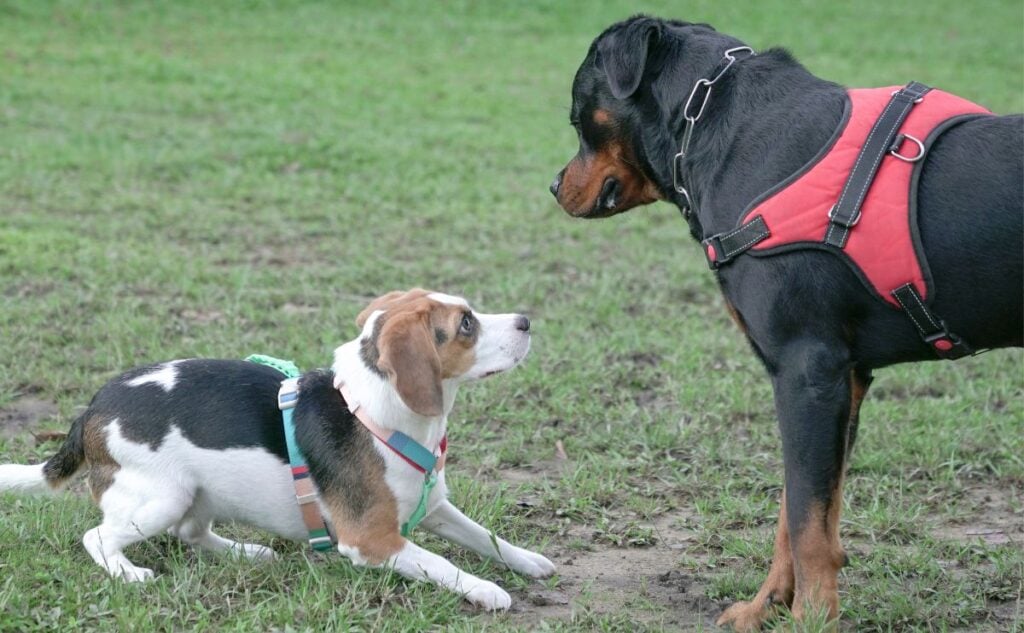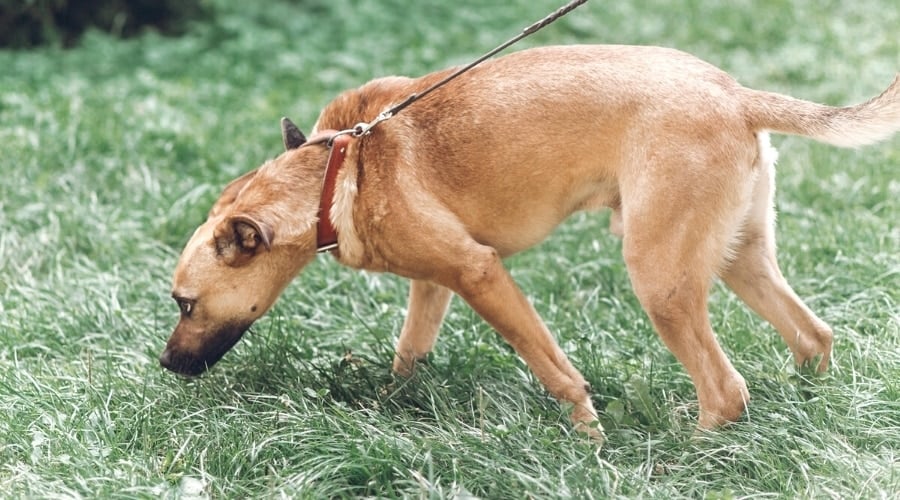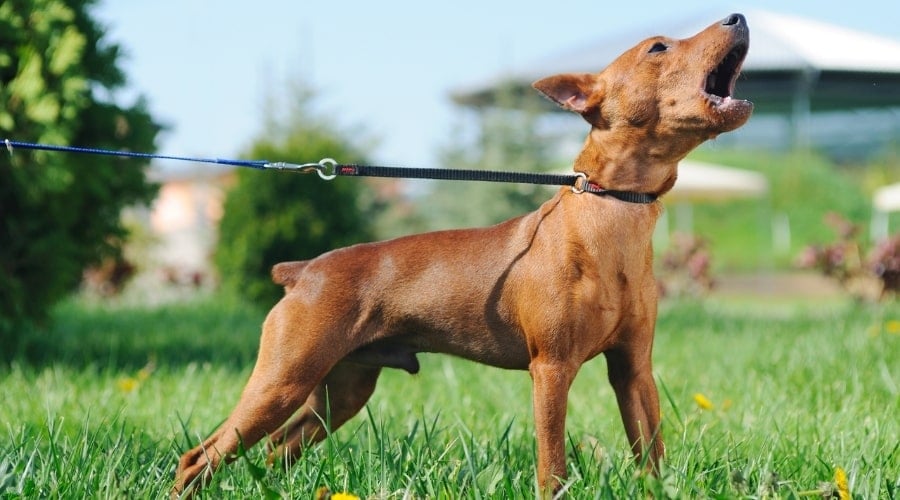Can Dogs Smell Fear? Understanding Your Pup’s Super Senses
When you purchase through links on our site, we may earn a commission. Here’s how it works.
Does your furry friend’s behavior change when they encounter someone who’s scared of dogs? Or you may have noticed your pup behaving unusually when you’re experiencing fear or stress. Canines can certainly detect our emotions, but is it solely through body language? Can dogs actually smell fear in humans and other animals?

Can Dogs Smell Fear?
A widely held belief is that you never want to show fear around a dog you don’t know because they may react aggressively toward you. Well, it turns out that you can’t hide fear from canines. Yes, it’s true. Dogs can actually smell fear — and other emotions like stress and happiness. Their noses know you inside and out. And the secret ingredient is our sweat.
How do they accomplish such a superhuman feat? It’s all in a dog’s outstanding olfactory anatomy. First of all, dogs have up to 300 million olfactory receptors, while we pale in comparison with only six million. This gives them a much stronger sniffing ability — 10,000 to 100,000 times more sensitive than humans.
However, the crown jewel of a dog’s sense of smell is the Jacobson’s organ, also known as the vomeronasal organ. This secondary olfactory tool allows dogs to not only detect but also interpret chemical signals from mammals and other animals, a superpower humans lack. This extraordinary organ, which sits in the nasal cavity at the top of the mouth, communicates with the brain through neural pathways and plays a crucial role in canines’ social communication, sexual behavior, and prey detection.
What Did Researchers Find?
In a 2017 study published in Animal Cognition, researchers at the University of Naples Federico II in Naples, Italy, confirmed their hypothesis that pet dogs could detect differences in fear and happiness in people by scent alone through chemosignals (body odors).
First, the research team collected sweat samples from the armpits of male human volunteers (who were not involved in the subsequent experiment with dogs) after they watched videos designed to cause fear, happiness, or a neutral response.
Then, scientists exposed dogs (Labrador and Golden Retrievers) to three stimuli—their owner, a stranger, and an odor dispenser containing either fear sweat, happy sweat, or no sweat (the control). They then monitored each dog’s heart rate, stress indicators, and behaviors (e.g., approaching, interacting, and gazing) directed to the three stimuli.
Researchers found that when the dogs were exposed to the happy sweat, they interacted more with the stranger than their owner and had lower heart rates. They also had lower heart rates when exposed to the neutral odor.

However, when dogs experienced the fear odor, they showed more signs of stress behaviors, had less interaction with strangers and sought reassurance from their owners. They also had significantly higher heart rates than in the happy and neutral conditions.
But here’s where this research got even more interesting in terms of dogs’ reactions. These pups didn’t exhibit aggressive behavior at all when they smelled fear. In fact, in the experiment, they exhibited signs of fear or uneasiness themselves. Of course, the owners and strangers weren’t displaying any body language that could cause dogs to feel aggressive.
Can Dogs Smell Stress?
A 2022 study by a team at Queen’s University Belfast in Belfast, North Ireland, found evidence that canines can also smell stress in human sweat and breath. This study involved four dogs and 36 humans.
Researchers gathered sweat and breath samples from participants both prior to and following a challenging math problem. Participants reported their stress levels before and after the task, and the researchers focused solely on samples from individuals whose blood pressure and heart rate had risen.
The dogs were trained to identify a lineup of scents and signal to the researchers which sample was the stress odor. At this point, the stress and relaxed samples were introduced. During each testing session, each dog received one relaxed and one stressed sample from the same individual, collected just four minutes apart. Remarkably, the dogs correctly identified the stress samples with an accuracy rate of over 90%.

What Animals Can Smell Fear Besides Dogs?
Dogs aren’t the only ones in the animal kingdom to hold the treasured Jacobson’s organ. But which ones are gifted? Scientists theorize that other animals exhibit the scent sensory ability to detect fear that dogs have due to the Jacobson’s organ. These include some other mammals, such as cats, horses, and cows. Reptiles, like snakes and lizards, and amphibians, including frogs and salamanders, also make the list. The scientific jury is still out on these other animals, but cursory research has suggested that it may occur in horses.
Can Bees Smell Fear?
There’s an old myth that bees sting us because they can smell our fear. While bees don’t have the Jacobson’s organ, they can smell fear by using their antennae. Honey bees have specialized receptors located on their antennae, specifically within thin hairs called sensilla, that detect airborne chemical compounds, like pheromones.
It’s believed that when bees detect the chemicals our bodies produce when we’re fearful, they interpret it as a threat and go into fight-or-flight mode. Honey bees can also share that scent with their hive members, warning them of potential danger. If nearby, this can quickly lead to a coordinated swarming response. This commnication method is essential for honey bees to protect their hive.
Frequently Asked Questions
Here are some common questions pup owners have about their pups regarding emotional and illness sensory. Don’t see yours here? Ask us in our comments, and we’ll do our best to answer.

Can Dogs Sense Fear In Humans?
Yes, dogs sense fear in humans using both their ability to read our body language and their sophisticated sense of smell.
Do Dogs Sense Fear In Other Animals?
Canines not only sense fear in humans, but they can do so in other mammals, reptiles, and amphibians. It’s an important way for them to detect prey and predators.
Can Dogs Smell Disease?
Recent studies show that dogs can detect specific scents involved with changes in human cell metabolism during various illnesses, including cancer, diabetes, Parkinson’s disease, epilepsy, malaria, COVID-19, and more.
Why Do Dogs’ Noses Have No Discretion?
If you have a sniff-crazy pup, you may find yourself in awkward situations at times. Is your dog one of those who goes all in with your house company’s crotch? If so, check out our article on why dogs smell crotches (and how to stop it!). More common than crotch sniffing, you’ve likely had to pry your pup’s snout away from another dog’s rear end. It’s that Jacobson’s organ hard at work again. Learn more about why dogs sniff other dogs’ butts.



